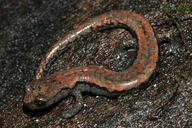|
Description
This species is robust, with a short trunk having 17-18 vertebrae, and well-developed limbs. Snout-vent length 51.9 mm in males and 58.2 mm in females. Like other members of the genus Batrachoseps, it has four toes on the hind limb, a large membraneous gap in the cranium, and an elongated tongue muscle. They have well-developed limbs, feet with four digits each with the third toe being noticeably longer than the others, well-developed subterminal pads, and insignificant webbing. The head is well demarcated from the neck, does not flatten, and has a prominent nasolabial groove that extends beyond the jaw line. Teeth that extend from the plate dividing the nostrils are in a moderately long series or in patches, and small premaxillary teeth appear in a moderately long series that ends under the eye. Females possess more premaxillary teeth than males. It has 16 to 17 costal groves, including one in the axilla and one in the groin. The tail is relatively robust and does not taper until near the tip.
Coloration includes a lightly pigemented dorsal stripe and dorsal mottling of rusty and grey. Iridophores cover the dorsal surfaces and group densely together to form the dorsal stripe. These iridophores may be bronze, tan, white, or reddish brown, and can be overlaid resulting in a complex mottling pattern. Black is evident between the costal grooves. The iris of the eye is dark with bronze highlights. There is a large degree of color variation over its range. The trends seems to be that the dorsum becomes lighter (gray or silver) in the drier regions where often the habitat substrate also tends to be lighter, whereas those found in red fir forest habitat tend to match the red and brown coloration of the downed and decaying tree litter.
Distribution and Habitat
Country distribution from AmphibiaWeb's database: United States U.S. state distribution from AmphibiaWeb's database: California
This species is found on the Kern Plateau on the southeastern Sierra Nevada through the eastern slopes of the lower Owens Valley, and south in the Scodie Mountains at elevations of 1615-2800 meters. Wake et. al (2002)
states that these organisms "occur in relatively extreme environments for terrestrial salamanders", in places with very hot and dry summers, short unpredicatable rainfall, and snowcover several months of the year. Salamanders are found in moist streamside soil often in wet meadows, in steep drainages, or in areas of runoff. Many localities are surrounded by dense stands of Red Fir (Abies magnifica), Jeffrey Pine (Pinus jeffreyi), and Singleleaf Pinyon Pine (Pinus monophylla). Other prevalent vegetation includes bigleaf sagebrush (Artemisia tridentata), willow (Salix sp.), and sedge grass (Carex sp.). Streamside vegetation includes monkeyflower and currant. Salammaders were mostly found in moist sandy soil, under rocks, in or beneath decaying logs, or within rock rubble and crevices. Rainfall is estimated to vary between less than 300mm per year and about 750 mm. While usually found singly, they have been found in small groups under or within rotting logs. The substrate temperature was measured at 13.5 C, with a range of 5.2�25.0 C (Wake et. al 2002).
Life History, Abundance, Activity, and Special Behaviors
Wake et. al (2002) hypothesize that surface activity for salamanders present at elevations below 2000 m is restricted to late winter and early spring, before surfaces heat up and lose their moisture. At high elevations, their activity is restricted to between the months of May or June to October, when temperatures are warmer and snow levels have dropped enough to provide conditions for courtship and egg-laying. It breeds terrestrially (IUCN) and clutch size, at least at higher elevations, is small and egg and hatchling size relatively large. Development of eggs in one experiment was shown to occur between 96 and 103 days. Juvenille salamanders were more frequently seen above ground in the late season than adults, probably due to their greater need to build up fat deposits for winter. When handled, salamanders try to crawl away, coil, or thrash, and sometimes produce a sticky skin secretion. Some rapidly coil and release, a behavior called a "watch-spring" response. Trends and Threats
Several thousand members of this species are said to exist, and there have been no notes made about a decline in population. The IUCN reports "the Kern Plateau and Scodie Mountain populations are on Forest Service land, but the level of protection may be inadequate". Since its range is narrow (<5000 sq. meters), it is categorized at "Near Threatened", close to Vulnerable. Comments
IUCN, Conservation International, and NatureServe. 2004. Global Amphibian Assessment. www.globalamphibians.org. Accessed on 25 March 2005.
Integrated Taxonomic Information System (ITIS) http://www.itis.usda.gov/index.html. Accessed March 2005.
References
Wake, D. B., Yanev, K. P., and Hansen, R. W. (2002). ''New species of slender salamander, genus Batrachoseps, from the Southern Sierra Nevada of California.'' Copeia, 2002(4), 1016–1028.
Originally submitted by: Shelly Lyser (first posted 2005-06-20)
Edited by: Tate Tunstall (2011-01-20)Species Account Citation: AmphibiaWeb 2011 Batrachoseps robustus: Kern Plateau Salamander <https://amphibiaweb.org/species/6060> University of California, Berkeley, CA, USA. Accessed May 31, 2025.
Feedback or comments about this page.
Citation: AmphibiaWeb. 2025. <https://amphibiaweb.org> University of California, Berkeley, CA, USA. Accessed 31 May 2025.
AmphibiaWeb's policy on data use.
|





 Raffaëlli Account
Raffaëlli Account Map of Life
Map of Life